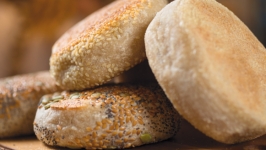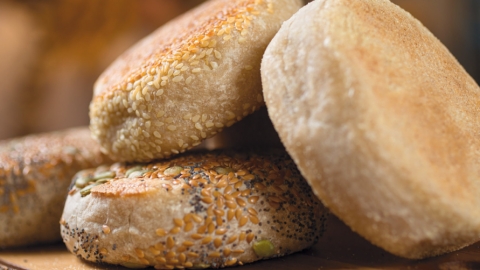Meet Jen Carson of LiLLiPiES, Princeton
BAKER: Jen Carson
RESTAURANT: LiLLiPiES
LOCATION: Princeton
Jen Carson’s exploration into sourdough began with a simple question asked by a baking instructor on the opening day of culinary school. “What’s the most memorable bread you ever had?”
Carson, the founder and baker at LiLLiPiES Bakery in Princeton, answered with a childhood memory of the moist, flavorful bread her mother used to buy from Vitiello Bakery in Nutley. In that class, Carson learned why the bread had tasted so good. “It was sourdough,” she says. “It was fermented and had that complex flavor and texture that you cannot get any other way.”
When Carson later landed a job developing the bakery menu for a new farm market, the shop’s enormous bread mixer forced her to explore ways to create a variety of products from a single large batch of sourdough. Trial and error eventually led her to a perfect vehicle for the tart, tangy dough: the English muffin.
Sourdough begins with a starter, which can be purchased or, sometimes, procured for free from an obliging bakery. Sourdough starter can also be made at home from scratch. Just be sure to start making it at least 10 days before you plan to make your muffins. This allows enough time for the starter to develop properly—plus a few extra days in case failure requires an emergency purchase of premade starter. [See related story, Sourdough on page 30.]
Carson has found that the starter process works best with rye flour, and that home bakers need to be patient about keeping the starter at room temperature until it becomes really active. “You have to monitor it for a good five days,” she says, “before it is active enough that you can start refrigerating it or not feeding it every day.”
If you want to serve sourdough English muffins on Saturday morning, begin making the dough on Thursday night by combining a small amount of starter with flour and water to create an activated starter. The next morning, when that mixture is light and bubbly, mix it with water and then add all-purpose flour, rye flour, salt, and a small amount of instant yeast. Check the yeast package carefully to be sure you purchased instant yeast, which can be added directly into the dough, and not active yeast, which must first be dissolved in water. You can also skip the yeast altogether and make a completely sourdough muffin by doubling the amount of activated starter. If you prefer to make muffins with whole-grain flour instead of white flour, increase the amount of water by 10 percent.
Knead the dough and leave it to ferment until it has doubled in size and jiggles when you lightly shake the bowl. If your kitchen is hot, it will take about an hour and 15 minutes for the dough to double. In a cool kitchen, it may take as long as two hours.
To shape the muffins, divide the dough into eight pieces. Form each piece into a mound, then roll it gently to make a smooth, seamless ball. While it is tempting to coat the dough with a lot of flour to keep it from sticking to your hands, Carson warns that excessive flour produces hard, dry muffins. “Embrace the stickiness,” she advises. “Flour your hands, rather than the dough. That way it will come off of your hands, but it won’t decrease the hydration of the dough.”
Roll the balls in sesame seeds or semolina, place them on a baking sheet that is coated in a thin layer of semolina to prevent sticking, and refrigerate the pan overnight. The next morning, brown the muffins on a dry (ungreased) cast iron skillet heated on the stovetop to between 300°F and 350°F. Return the browned muffins to the baking sheet and bake them until cooked all the way through [see accompanying recipe].
From the start of her professional baking career, Carson has focused on sourdough. Because fermentation relies on ambient microorganisms, sourdough, for her, represents a true taste of place. And sourdough allows her to recreate the moist, chewy texture and nutty, slightly Cheddary flavor that she remembers from the bread her mother treated her to as a child.
“Once I really started delving into sourdough, I realized that someone is going to taste my bread and have that same epiphany,” Carson says. “They’re going to have that same awakening of ‘Oh, this is what bread can be!’”
“It doesn’t need butter,” she adds. “It’s not a delivery device for roast beef. It’s a really good food all on its own.”
LiLLiPiES Bakery
301 N. Harrison St.
Princeton[Princeton Shopping Center]
609.423.2100
lillipies.com






